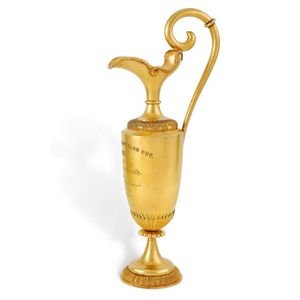Adelaide Hunt Club Cup, 1881 by Henry Steiner
You must be a subscriber, and be logged in to view price and dealer details.
Subscribe Now to view actual auction price for this item
When you subscribe, you have the option of setting the currency in which to display prices to $Au, $US, $NZ or Stg.
- Important - Important is a word used in the antique trade to indicate an object should be ranked above other similar objects, and is therefore more valuable.
The object could be considered important because it is by a famous designer or maker, has been shown at a major exhibition, is of exquisite workmanship, is rare or is a "one-off", was made for an important patron, and so on.
Even further up the pecking order are objects that are described in catalogue descriptions as highly important or extraordinarily important. - Acanthus - A stylized leaf motif, one of the primary decorative elements of classical Greek and Roman architecture, derived from the genus of flowering plants in the family Acanthaceae, native to tropical and subtropical regions of the Mediterranean area. It is a common element in classical Greek and Roman design, and is often seen in Corinthian and Composite order columns and used as a decorative element in English, European and Australian furniture, particularly on the curve of a leg, and as decoration for a corbel.
This item has been included into following indexes:
Visually similar items

A French Art Nouveau porcelain and ormolu table lamp, circa 1900, the baluster shaped vase in mottled sea green overlaid with finely engraved ormolu Asteraceae flowers, with pierced decorations to the neck and base and raised upon a stepped bronze footed p

An Australian sterling silver claret jug attributed to Edward Fischer, Geelong, of baluster form with scroll handle, the body engraved with foliate work around two cartouches featuring an engraved scene of two horses racing & 'Hay jockey club Member's cup

Two Royal Doulton cabinet vases, both baluster shaped, raised on circular spreading bases, both with cobalt grounds heavily gilded and each with two handles, one with a hand painted panel of summer flowers signed E. Wood. Tallest 17.5 cm

Pair of French marble candlesticks, approx 27 cm high (2)
